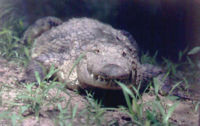Crocodile
 From Conservapedia - Reading time: 3 min
From Conservapedia - Reading time: 3 min
| Crocodile | |
|---|---|

| |
| Scientific classification | |
| Kingdom Information | |
| Kingdom | Animalia |
| Phylum Information | |
| Phylum | Chordata |
| Class Information | |
| Class | Reptilia |
| Order Information | |
| Order | Crocodilia |
| Family Information | |
| Family | Crocodylidae |
| Genus Information | |
| Genera | Crocodylus Osteolaemus |
| Species Information | |
| Species | C. acutus C. cataphractus C. intermedius C. johnsoni C. mindorensis C. moreletii C. niloticus C. novaeguineae C. palustris C. porosus C. rhombifer C. siamensis O. tetraspis |
| Population statistics | |
Crocodiles and their close relations alligators, caimans and gavials, form the family Crocodylidae. Crocodiles are found in areas of higher temperature, primarily in sub-Saharan Africa, India and South-East Asia, Indonesia and Australia, and throughout tropical America. Until recently Nile crocodiles were also found throughout North Africa, and in Palestine.[1]
In the evolutionary view, crocodiles emerged in the late triassic period from early archosauromorphs.
Contents
Species of crocodile[edit]
- Nile crocodile Crocodylus niloticus (Africa)
- American crocodile Crocodylus acutus (Caribbean Sea, including the southern United States)
- Morelet's crocodile Crocodylus moreletii (Central America)
- Cuban crocodile Crocodylus rhombifer (Cuba)
- Mugger crocodile Crocodylus palustris (India)
- Estuarine crocodile Crocodylus porosus (Australia and South-East Asia)
- Johnstone's crocodile Crocodylus johnsoni (Australia)
- Siamese crocodile Crocodylus siamensis (South-East Asia)
- Philippine crocodile Crocodylus mindorensis (Philippines)
- Orinoco crocodile Crocodylus intermedius (South America)
- New Guinea crocodile Crocodylus novaeguineae (New Guinea)
- Dwarf crocodile Osteolaemus tetraspis (Sub-Saharan Africa)
Morphology[edit]
The name Crocodile came in Ancient Greece, and means 'lizard'. On external appearance, crocodiles resemble large aquatic lizards. However, Crocodiles, and other members of the family Crocodylidae are among the more biologically complex reptiles. Unlike most other reptiles, the Crocodiles possess a four-chambered heart, a feature mostly shown exclusively in birds and mammals. Other features include a diaphragm-like structure, again seen mostly in birds and mammals, and a cerebral cortex - the part of the brain mostly responsible for self-consciousness and the ability to learn. The crocodile, internally, is closer to that of a bird than to lizards, despite looking strikingly similar to other reptiles.
Members of the family Crocodylidae possess streamlined bodies and webbed feet, demonstrating its largely aquatic nature. However, most Crocodilians are also well adapted for terrestrial terrains. They can for example, run (or gallop) at speeds of up to 15 kph.
Behaviour[edit]
Crocodiles generally capture their prey, often large mammals such as antelopes, by drifting close to them, motionless, then lunging and dragging their victim underwater, where it is drowned, then left to rot and soften up for later consumption.
Crocodiles typically lay their eggs in a mound of rotting vegetation; the mother will guard the nest from marauding egg-thieves, and solicitously adjust the depth to which the eggs are buried. When the baby crocodiles hatch, she will carry them to the water in her mouth. Hatchlings are precocial (able to fend for themselves at birth), though they stay with the mother for some time after hatching.
Many crocodiles aestivate during summer.
Crocodile Products[edit]
Crocodiles are commercially farmed in many places, for their leather, which is made into expensive shoes and handbags, and recently, in Australia, for their meat. In areas where Crocodiles are farmed, there is a strong incentive to protect the natural habitat in order to keep an efficient system where profit is sustained and the crocodile population and local food chains are unharmed.
Danger to Humans[edit]
Three species, the Nile crocodile of Africa, the Mugger crocodile of India and the Estuarine crocodile of Australia and South-East Asia, have a long history of attacking humans who enter the crocodile habitats.
Crocodiles in the Bible[edit]
Some Biblical scholars have suggested that Leviathan may have been a crocodile, though others dispute this. [1]
References[edit]
| ||||||||
 KSF
KSF